Businesses use the internet to gather customer insights and craft tailored offers that entice customers to give their products or services a try. This process, known as lead generation, is a vital component of any marketing strategy, big or small.
The rise of online businesses has given consumers a plethora of choices, making it tougher for companies to grab their attention and persuade them to invest in their products or services.
Lead is a potential customer who has shown some interest in a business’s product or service. To understand how to generate new business leads, companies engage in various marketing activities such as social media, content marketing, and email campaigns. Once a lead qualifies, offering free trials, demos, or discounts can help nurture and convert them into paying customers.
For a comprehensive understanding of effective strategies for generating B2B leads and tailoring lead generation strategies for small businesses, it’s crucial to first identify and understand the two main types of leads that are further broken down but essentially are within these groups.
Each type of lead requires a different approach in terms of marketing lead generation and communication. Understanding and effectively categorizing these leads can significantly enhance the efficiency and success of sales and marketing strategies for new lead generation. We’ll talk more about cold and warm leads.

A cold lead is a sales prospect with no prior interaction or relationship established with the salesperson or company contacting them. Cold leads are identified through public sources like directories or purchased lead lists rather than organically through referrals or a company website.
The salesperson has no familiarity with the prospect’s needs. Since no trust or rapport has been built, cold leads typically have a lower response rate than warmer leads already engaged in the sales process.
Converting cold leads into paying customers takes more effort than converting warm leads because they have no prior connection with the business.
Nurturing cold leads demands targeted efforts, but it’s worth it because it can increase sales and revenue. Here are three lead generation strategies to get started:
Warm leads are better for the business and are more likely to convert than cold leads because they had some previous interaction with a salesperson or company, indicating a basic level of interest or familiarity. They may have visited the website, filled out a form, or signed up for the newsletter. However, even warm leads need follow-up and nurturing to convert them into paying customers.
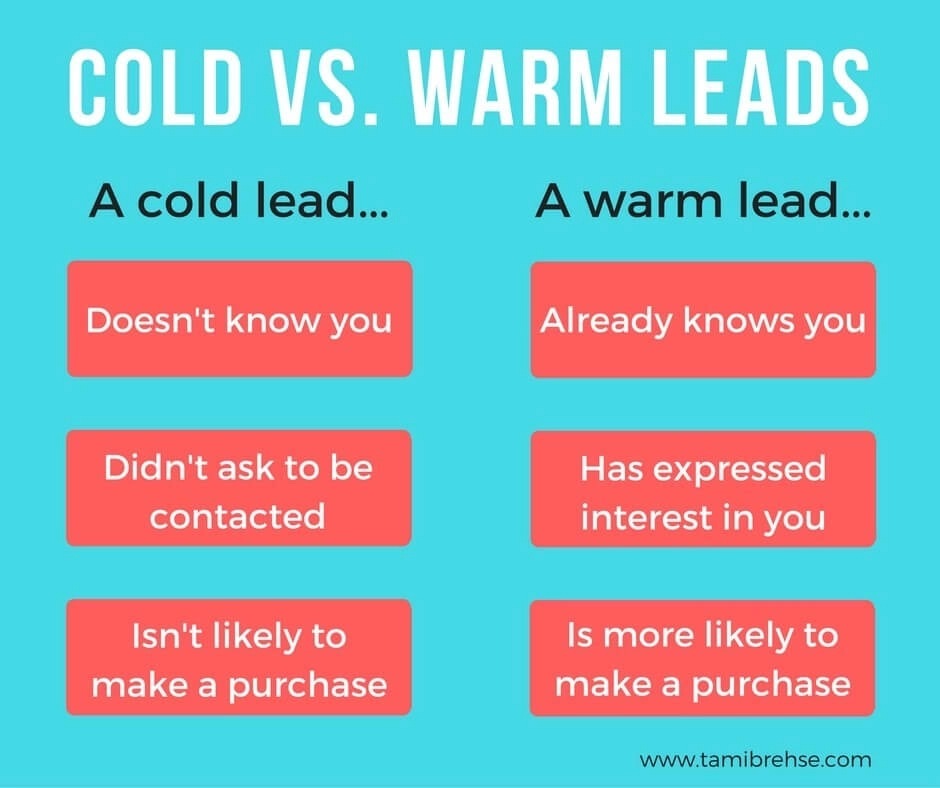
Image source: tamibrehse.com
Lead generation is the process of attracting and converting strangers and prospects into someone who has indicated interest in a company’s product or service. This is typically achieved through various marketing tactics such as content marketing, advertising, and events, aimed at initiating consumer interest or inquiry.
“Lead generation is a fairly core activity to marketing.“
– Chris Brogan, Human Business Works
Lead generation means attracting and converting new customers. It involves using marketing campaigns to find business leads and connecting them with the sales team to recommend personalized products or services. This process is especially crucial in B2B lead generation, where the focus is on attracting leads that are other businesses.
Lead generation is the essential process of identifying and cultivating new potential customers for a business. There are many strategies to generate new business leads and tactics companies can leverage to grow their pipelines.
Here are some of the most effective new sales lead generation strategies:
For B2B lead generation, it is important to understand who the target customers are and what they need and then offer products or services that meet those needs. A data-driven approach can ensure a more nuanced understanding of the target customers’ needs and preferences, which will result in finding new business leads. For example:
An ideal customer profile (ICP) is a detailed description of a business’s best-fit customer, encompassing key demographics, behaviors, values, and other attributes. Creating an ICP is a strategic approach to getting new business leads as it helps your sales and marketing teams identify qualified prospects that closely match the profile and are more likely to benefit from the company’s offerings.
The ideal customer has a pressing problem that the product or service can effectively and efficiently solve. Defining the ideal customer profile enables you to tailor messaging, product development, and go-to-market strategies toward attracting and converting this clearly defined audience.
An ideal customer profile (ICP) can be created by the following:
Developing an ICP is a critical first step in creating a strategy for lead generation for small businesses, as it defines the most essential element: the target audience.
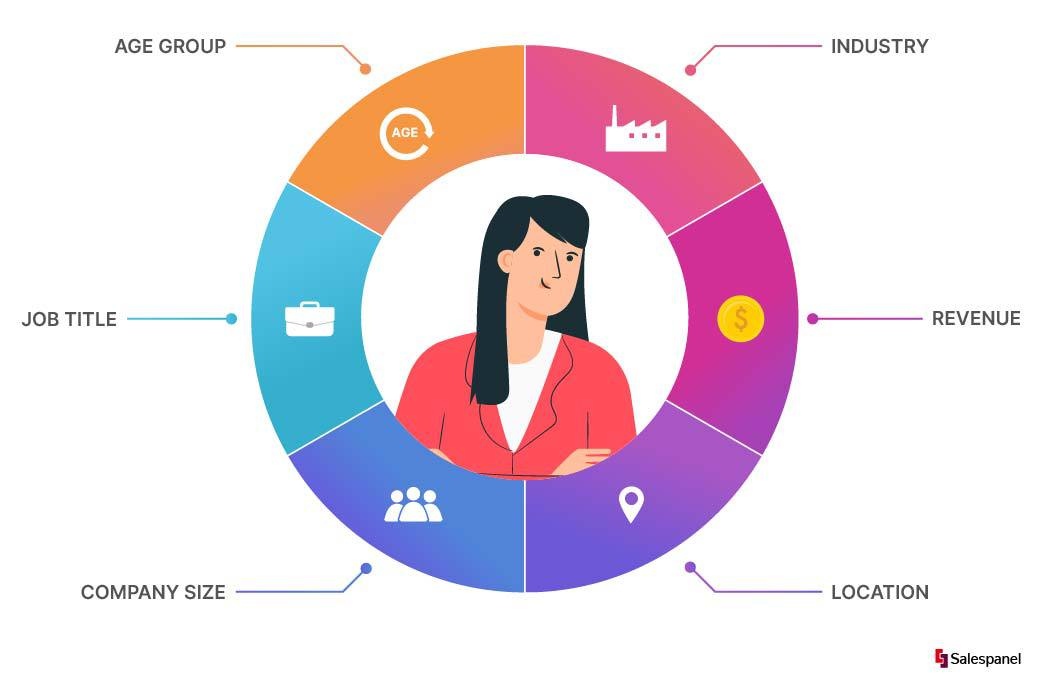
Image source: salespanel.io
A buyer persona is a more detailed representation of the ideal customer. It is a semi-fictional representation that includes the customer’s personal information, job title, pain points, and buying behavior. This information can be derived from various sources, including the current customer database, website analytics, and market research.
Online search and social media are the top two places people discover new businesses. Therefore, having a strong presence on social media platforms (such as Facebook, Instagram, and Twitter) is crucial for generating new B2B business leads and spreading brand awareness.
Optimize the digital presence by following these tips:
Additionally, a high-quality business website plays a key role in creating a digital footprint and collecting small business marketing leads, as it is the first thing a potential customer checks before purchasing a product or service. It also communicates a professional brand image, where visitors can browse available products and services, fill out forms, benefit from a free trial, and engage in other practices that generate new business leads.
Improve the website visibility by following these tips:
“Content is the fuel for your lead generation efforts.“
– Dayna Rothman, CMO at Censys
Visitors must find value on social media platforms and business websites beyond the products and services available for purchase. Helpful, customized blog posts, videos, and free demos can generate new business leads.
A healthy lead generation strategy is when visitors feel that a business accurately addresses their wants, needs, preferences, and pain points rather than solely focusing on extracting their money. Companies can implement such a strategy through the following:
Consider aligning the content strategy with the buyer’s journey, focusing on content clusters that cater to different stages, which is the best way to get leads for business.
In addition to high-quality content, your business must optimize its websites for search engines. Search engine optimization (SEO) efforts contribute to improving a website’s content to ensure it ranks high in search results.
This is achieved through keyword research to identify relevant terms and themes that target audience members search for. The website content is then optimized to focus on those themes using keywords naturally in titles, headers, meta descriptions, image alt text, and body content.
Effective and natural incorporation of target keywords, along with a website designed for an optimal user experience, will contribute to search rankings so the content appears at the top of search engine results pages when users search for related topics.
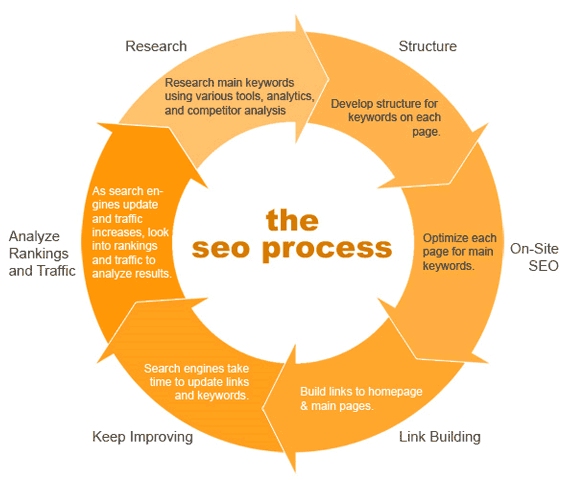
Image source is neilpatel.com
A landing page is a standalone homepage or entry point to a website where visitors take a specific action, such as making a purchase, filling out a form, or donating. This is where visitors convert into paying customers or bounce away. This landing page optimization process involves making the landing page visually appealing and professional.
Therefore, landing pages must be visually appealing and professional, with concise, persuasive copywriting and a simple layout highlighting important information (e.g., headline, value proposition, call to action (CTA)) so visitors can take immediate action without confusion or hesitation.
Landing Page Redesign for @VectorConsultin ✨
✅ Move VSL to hero
✅ Social Proof after CTA
✅ Optimize the headline for conversionsHere’s what I would do to get them more booked calls:
<< THREAD 🧵 >> pic.twitter.com/3l4IkdgCfI
— Shane | Killer Landing Pages 🚀 (@theshaneduggan) November 21, 2023
A website form is the final and one of the most important steps in the lead generation strategy, as it’s where visitors either provide the required information or lose interest. According to Hubspot, the conversion rate improves by almost half when the number of form fields is reduced from four to three. Additionally, the lead capture text must offer value and be compelling and concise, such as “Sign up for a 10% discount on your next purchase.”
Follow these tips to optimize website forms:
A user-friendly form is easy to use, mobile-friendly, clear, and concise. When visitors find a form smooth and easy to use, they are more likely to complete it and provide all the necessary information; this directly contributes to an increased conversion rate. Your businesses can improve customer satisfaction and foster loyalty by prioritizing user experience (UX) and providing visitors with a seamless experience.
Conversion rate optimization focuses heavily on streamlining form fields to reduce friction in the lead capture process. Too many form fields or unclear questions can cause prospects to abandon forms and fail to convert them into leads.
Here are some tips for optimizing web forms to improve conversion:
Regarding successful marketing lead generation strategies, it’s crucial to understand that time is valuable for potential leads is essential. This is particularly true when aiming to get new business leads. Overly long forms with numerous fields can be off-putting, resulting in higher bounce rates. To avoid this, your business should request only the most crucial information, such as names, email addresses, and key professional details.
Streamlining form fields not only speeds up the submission process for users but also enhances their experience. Completing a form quickly imparts a sense of satisfaction and efficiency. Moreover, it signals to your potential leads that you value their time, refraining from requesting unnecessary information upfront, a critical factor in successful lead generation efforts.
Having too many form fields can feel overwhelming and prompt users to abandon forms. A more concise form improves conversion rates while still capturing key information from leads. Of course, privacy should still be assured through an easily accessible policy. However, focusing on user experience is the priority.
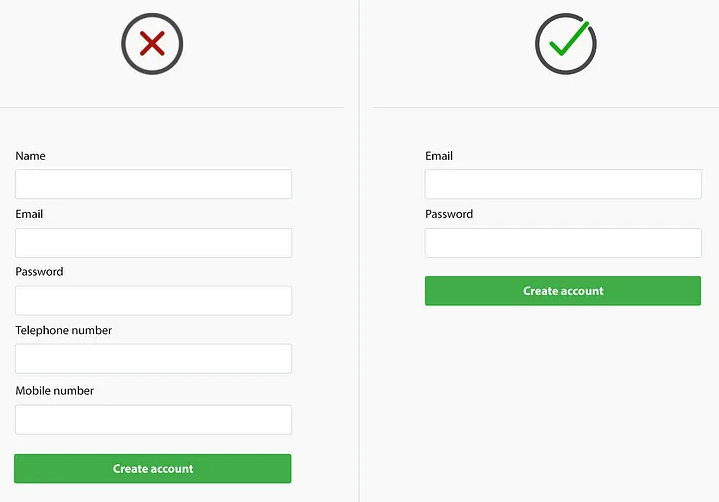
Image source: uxplanet.org
Consider using clear, concise language on your website forms to help visitors easily understand and fill them out, which is a fundamental aspect of generating leads for small businesses. This not only helps users quickly find and comprehend the information but also builds trust and credibility with audiences by showing them respect for their time.
Using plain language that avoids overly technical terms or industry jargon makes the process simple for visitors, a key element in B2B lead generation. The goal is to create an effortless experience for submissions, which is crucial in attracting and converting leads in both small business and B2B contexts.
Bombarding visitors with at a time can create friction and reduce the likelihood of finding new business leads. Even interested customers may have difficulty completing a lengthy form, let alone new ones. However, dividing the form into multiple pages and using progress indicators can make it enjoyable to complete, even if there are many questions.
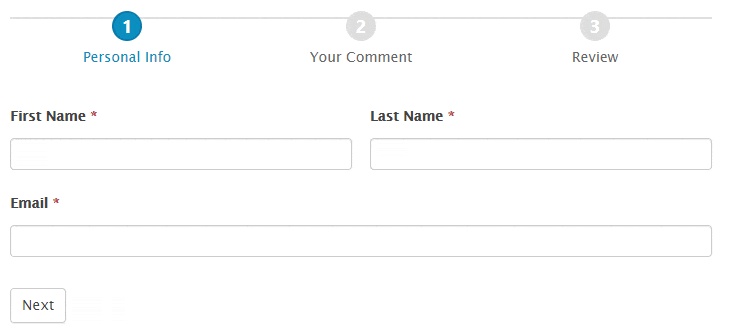
Video source is formidableforms.com
A/B testing is a practical method for optimizing a website’s features by comparing two versions of the same page. It allows you to test different variables, such as questions, headlines, calls to action, and more, to determine which version performs better.
By randomly assigning visitors to one of the two versions, your businesses can continuously improve their marketing lead generation forms and tailor them to their customer’s preferences and desires.
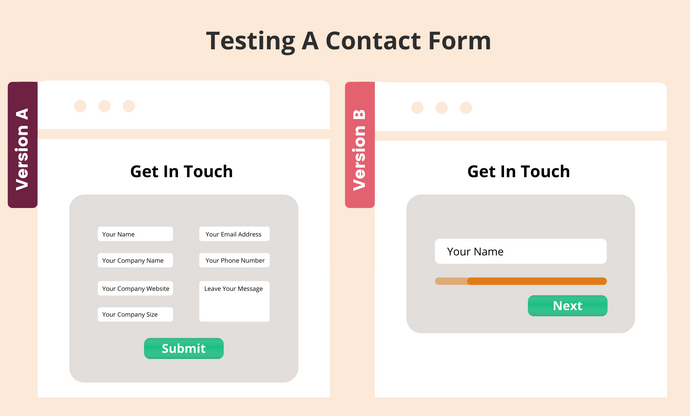
Image source: joinative.com
A thank you page is essential at the end of any lead generation strategy for website form, as it offers several advantages. It can provide additional information about the business, encourage further actions such as following social media pages or visiting links within the website, and show appreciation to visitors for taking the time to complete the form.
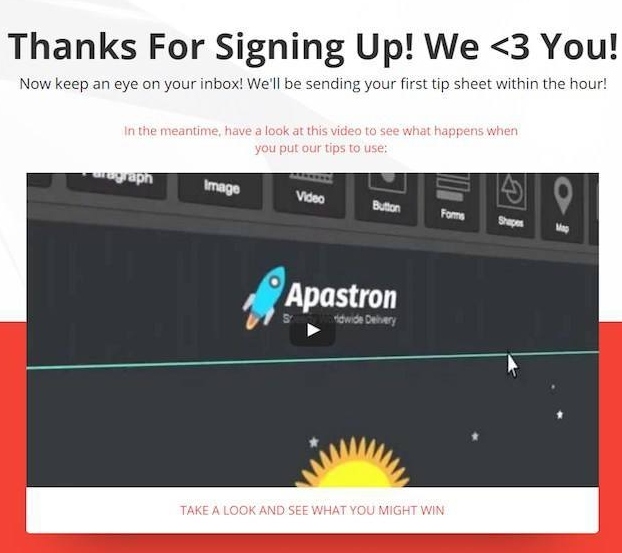
Image source: instapage.com
Word-of-mouth marketing lead generation is one of the most effective strategies because consumers are more likely to trust recommendations from other consumers than business marketing messages.
Develop a structured referral program with generous incentives for satisfied customers. For example, provide shareable promo codes, discounts, or rewards to customers who refer new leads. Make the process seamless by giving referral links or enabling easy social sharing. Follow up with referred leads to track success and ensure customers who made the referrals feel appreciated.
Lead nurturing workflow guides leads to becoming paying customers by sending valuable and relevant content based on their information. Lead analysis and response are crucial for turning leads into customers.
Since not all leads are equal, the content should not be identical. Prioritize leads with higher conversion chances and contact them more frequently. Personalized content can go the extra mile. Using leads’ names and social media profiles to identify their interests shows that a business cares and can help build a strong relationship, ultimately contributing to a higher conversion rate.
Social media is an effective, modern, and accessible tool for lead generation, given that internet users worldwide spend 151 minutes daily on average on social media, and there are 308.27 million social media users in the US alone, according to a survey by Statista. Creative content, chatbots for lead qualification, giveaways, and SM ads are all effective ways to reach a broad audience and generate leads rapidly.
Emails are a powerful channel to capture leads and drive them to the sales funnel. Mailbutler has noted that 99% of email users check their inbox daily. Moreover, emails allow for the automation of the lead capture process, saving time and reaching a larger lead base.
Follow these tips to improve the email campaign performance:
You can also provide lead magnets through emails, such as e-books, early access to new products, discounts, and free trials, which can generate new high-quality business leads, get them to experience a product or service, and explore why they should invest in it.
Paid media campaigns use paid advertisements to generate or convert leads. These campaigns are typically conducted on platforms such as Google Ads, LinkedIn Ads, and X Ads. Quick tips to leverage paid media campaigns:
Use ad remarketing. It allows showing ads to people who have already visited the business’s website. This is a great strategy for generating marketing leads, as it is the way to stay top-of-mind and encourage people to return to the website and make a purchase.
However, the advantages of this strategy are well worth it: paid media campaigns yield fast results in B2B lead generation, and your businesses can track the success of various metrics (e.g., click-through rates, conversion rates, etc.) and make immediate improvements.
Whether for small business lead generation or B2B lead generation, capturing leads and closing deals require constant analysis and tracking. By staying updated with the performance of lead generation forms, using form analytics, and analyzing how the audience is receiving them, your marketing team can pinpoint the weaknesses and strengths of the forms and develop updated, engaging, and efficient ones. Analytics tools such as Google Analytics are suitable for generating leads for both small and large businesses.
Google Analytics is a powerful analysis and tracking tool offered by Google that is suitable for businesses of all sizes. In addition to the many services it provides for various aspects of a website, it enables tracking the performance of lead forms by identifying session duration, information about the traffic source, conversion rate, bounce rate, competitors’ pages, and the most effective keywords.
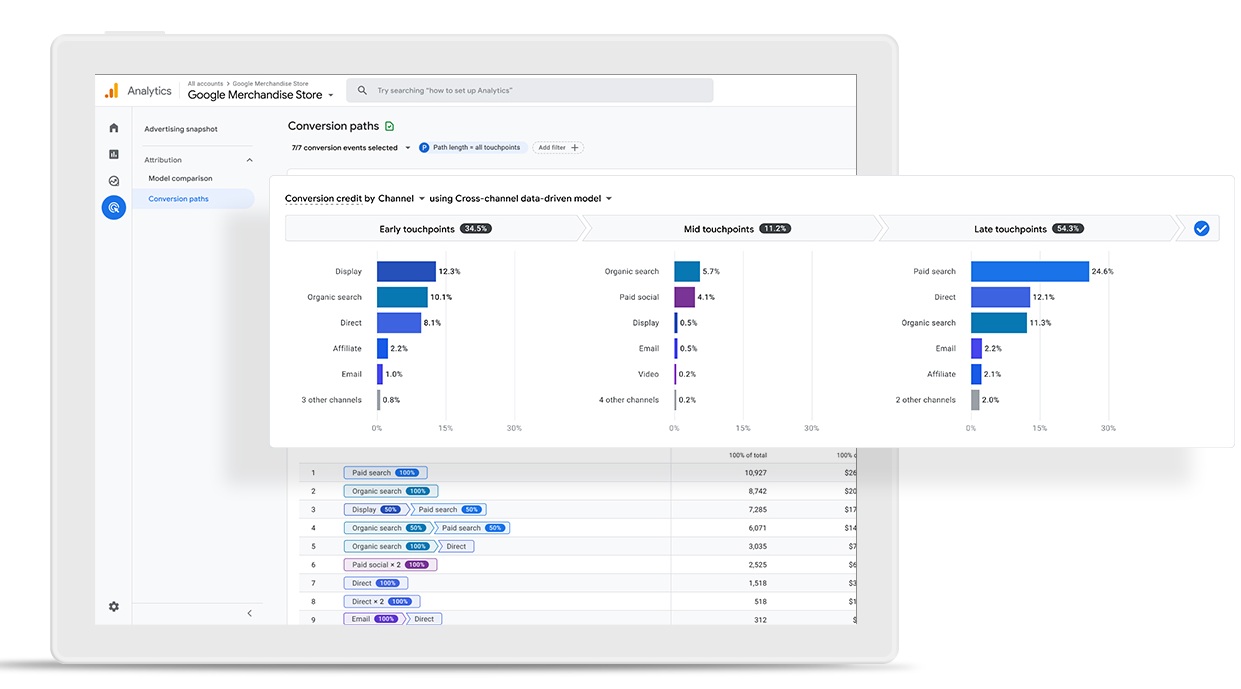
Image source marketingplatform.google.com
Sales Force is a CRM tool that is one of the best for lead capture analysis and improvement. It offers numerous options for tracking leads, including web-to-lead forms, marketing lead generation reports, lead source reports, and more. Additionally, create custom reports to track specific variables.
In addition to tracking lead forms, this tool allows you to automate lead capture, reach a broader audience, and segment leads.

Image source salesforce.com
FormStory’s advanced features do more than just keep track of form submissions, bounces, and conversions. They also have a special feature that saves all form submissions, even if the forms have problems. The insights gained from form tracking data are highly beneficial for businesses, as they play an important role in enhancing the lead generation process by providing essential insights about potential leads visiting their website. This feature ensures that no valuable lead information is lost, significantly aiding in the optimization of lead generation strategies.
HubSpot’s free lead tracking tool is perfect for small businesses that plan to expand. It’s comprehensive and easy to use, and it allows you to:
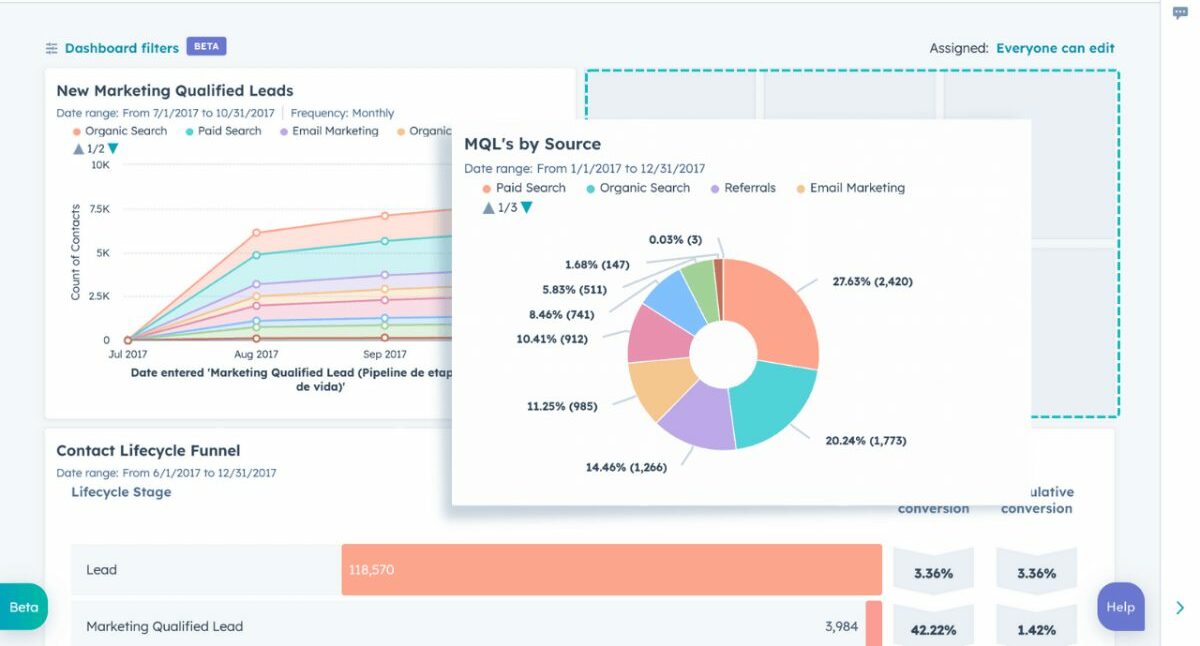
Lead generation is the first step in any marketing campaign, so it’s essential to do it right. The tips above demonstrate how to generate new business leads and provide valuable insights to help you improve both B2B and small business lead generation. However, another essential piece of the puzzle is using the right analysis and tracking tools. No business can create a perfect lead capture form without understanding how users interact with and respond to these forms.